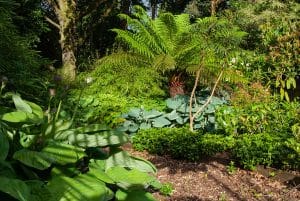Time to brighten up those shady areas of your garden! Everyone adores a sunny garden with bold and bright blooms. But shady gardens also deserve some love.

These shade perennials boast beautiful leaf colours and delicate, exotic flowers – and some have irresistibly cool names too! Remember: Full shade means the area never gets direct sunlight. Part shade means it doesn’t get more than 3 or 4 hours of sun daily.
Hostas
Hostas is a go-to plant for shady areas with moist soil. Primarily a foliage plant, the broad-leafed beauty can actually be very small
or very large. “Sum and Substance is a variety that gets huge – about five feet across,” says Beyers. “Meanwhile, Mouse Ears is really, really tiny.”
Varieties to try: Halcyon, Sum and Substance, Mouse Ears
Ligularia
Sometimes called “leopard plant,” Ligularia is an excellent choice for any shade garden – and not just because deer don’t enjoy eating it. “One of the other nice things about this plant is its striking, purplish-red leaves,” adds Daryl Beyers, author of The New Gardener’s Handbook. “There’s another variety that features yellow, daisy-looking flowers, and yet another called ‘The Rocket’ that boasts spikier blooms.” If you’re looking for a plant with a large leaf structure, this might be your best bet.
Varieties to try: Desdemona, Britt-Marie Crawford, The Rocket
Astilbe
Lacey, toothed leaves and feathery plumes of pink, white, red, or purple flowers bloom in profusion in early to midsummer. A little morning sun helps them bloom better.
Varieties to try: Younique Lilac, Milk and Honey
Ferns
Frothy-looking ferns are sturdier than they appear, popping up again after even the toughest winters. They like somewhat moist ground but are fairly drought-tolerant once established.
Varieties to try: Autumn, Japanese Painted
Viola
These spring bloomers tolerate some sun, but they prefer part to full shade, especially in the heat of summer. Some types are fragrant, too.
Varieties to try: Penny Purple Picotee, Johnny Jump-Up
Asarum canadense
Asarum canadense – Canadian wild ginger – is an interesting native plant to choose for your shade garden. It’s a low-grower and prefers the deepest shade with a moist soil. “It actually does make flowers,” Beyers adds. “They’re just not very showy.”
Spiderwort
Spiderwort or Tradescantia is a part shade – not deep shade – plant. It features a beautiful flower and can grow anywhere from
a foot-and-a-half to two feet tall. “The variety Sweet Kate has unique, chartreuse-coloured leaves, so I recommend checking it out,” advises Beyers.
Varieties to try: Sweet Kate, Concord Grape
Epimedium
These little plants are also known as fairy wings or bishop’s cap due to the adorable shape of their flowers, which appear in early spring. They don’t like foot traffic, so plant them where they won’t be stepped on.
Varieties to try: Pink Champagne, Lilafee
Tiarella (Foamflower)
Lobed foliage with red or purple veins make this plant interesting. Floaty little flowers arise on long stems in late spring to early
summer.
Varieties to try: Cutting Edge, Jade Peacock
Hellebore (Lenten Rose)
These evergreen plants produce unusual, long-lasting blooms in late winter or very early spring. Pick a spot and stick with it; they don’t like to be moved once established.
Varieties to try: Phoenix, Kingston Cardina
Lamium (Dead Nettle)
Silvery, variegated foliage and yellow, pink, or purple blooms make this a great addition to the shade landscape. It’s not super fussy and does well in dry areas.
Varieties to try: Beacon Silver, Herman’s Pride
Bletilla (Ground Orchid)
You’ll fall in love with this exotic-looking flower that appears in early spring in white, purple, and various shades of pink. Its blooms often last up to six weeks. It’s an unusual landscape plant for warmer climates, or it can be overwintered indoors in containers.
Varieties to try: White Pearl, Kate
Toad Lily
The intricate flowers (spotted like a toad!) are the reason to grow these little gems. They bloom mid-to-late summer to fall in a variety of spotted colours ranging from white to lavender.
Varieties to try: Purple Beauty, Raspberry Mousse
Heuchera (Coral Bells)
Grown primarily for its pretty ruffled foliage, this perennial’s mounding habit shoots up small flower spikes with teeny flowers in spring to mid-summer. It will tolerate some sun, but its best colour typically occurs in shade.
Varieties to try: Obsidian, Peachberry Ice
Brunnera (Siberian Bugloss)
This perennial is grown for its striking foliage and graceful sprays of tiny blue flowers, which appear in spring. It’s a hardy, low maintenance plant.
Varieties to try: Jack Frost, Alexander’s Great
Corydalis
Tubular lightly-scented spring flowers hang above finely-cut foliage. The plant may die back in summer and sprout again in fall.
Varieties to try: Purple Bird, Blue Line Couriblue
Bleeding Heart (Dicentra)
Charming sprays of heart-shaped flowers in early summer make this old-fashioned favourite a must-have. The flowers come in a variety of colours ranging from deep red to pink with lime-green to dark green foliage.
Varieties to try: King of Hearts, Valentine
Lungwort (Pulmonaria)
This pretty ground cover blooms in early to late spring with small bell-shaped flowers and spotted foliage. It looks best planted en masse. The name comes from its historic usage to treat lung ailments!
Varieties to try: Raspberry Splash, Sissinghurst White
Trillium
The triangular shape and three leaves below the blooms of this striking native flower gives the plant its name. It’s hardy, showy, and tolerates wet soil.
Varieties to try: White, Red
Foxglove
Although this perennial blooms well in full sun, it tolerates part shade, especially in hot climates. The tall spiked flowers are a standard in cottage gardens.
Varieties to try: Polkadot Princess, Foxy
Jack-in-the-Pulpit
This intriguing native perennial blooms in late spring. The flower spike is the “jack” while the hood is the “pulpit.”
Varieties to try: Crossing Over, Triphyllum
Lily of the Valley
These delicate bells dangle on short stems and have a strong fragrance. It’s a ground cover that spreads readily, so be careful where you plant it.
Varieties to try: Bordeaux, Rose
Caladium
Huge heart-shaped leaves in splashy colours offer plenty of drama. They’re tropical so if you live in a cool climate, put them in pots so they can be brought indoors and enjoyed as a houseplant over
the winter.
Varieties to try: Red Flash, White Christmas
Solomon’s Seal
This perennial boasts a thick blanket of deep-green leaves that grow on upright red stems. Pendulous tuber-shaped flowers dangle from the stems in late spring and become bluish berries in the fall.
Varieties to try: Ruby Slippers, Fireworks
(Article source: Country Living)

